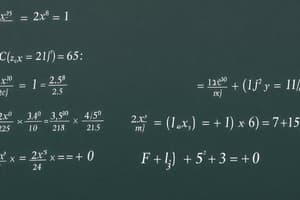Podcast
Questions and Answers
What is the general form of a quadratic equation?
What is the general form of a quadratic equation?
In probability, what type of number quantifies the likelihood of an event occurring?
In probability, what type of number quantifies the likelihood of an event occurring?
Which trigonometric function is defined as the ratio of the length of the opposite side to the length of the hypotenuse in a right triangle?
Which trigonometric function is defined as the ratio of the length of the opposite side to the length of the hypotenuse in a right triangle?
Which method can be used to solve quadratic equations by transforming them into perfect squares?
Which method can be used to solve quadratic equations by transforming them into perfect squares?
Signup and view all the answers
What kind of geometry focuses on figures such as circles, lines, angles, and distances on a plane?
What kind of geometry focuses on figures such as circles, lines, angles, and distances on a plane?
Signup and view all the answers
What geometric shape is studied extensively in coordinate geometry?
What geometric shape is studied extensively in coordinate geometry?
Signup and view all the answers
Which branch of mathematics is used to analyze sound and light waves in physics?
Which branch of mathematics is used to analyze sound and light waves in physics?
Signup and view all the answers
What mathematical concept is used to design buildings, roads, and electrical systems?
What mathematical concept is used to design buildings, roads, and electrical systems?
Signup and view all the answers
Which type of equations are used to model population growth and decay?
Which type of equations are used to model population growth and decay?
Signup and view all the answers
What are the formulas in coordinate geometry used for finding the equation of a tangent line to a circle based on?
What are the formulas in coordinate geometry used for finding the equation of a tangent line to a circle based on?
Signup and view all the answers
Study Notes
Exploring Mathematics: Quadratic Equations, Trigonometry, Probability, and Geometry
Mathematics is a diverse and interconnected subject that shapes our understanding of the world around us. In this article, we'll delve into several key areas of math, focusing on quadratic equations, trigonometry, probability, and circle and coordinate geometry.
Quadratic Equations
Quadratic equations are second-degree polynomial functions, taking the form (ax^2 + bx + c = 0) where (a, b, c \in \mathbb{R}). These equations can be solved using the quadratic formula, factoring, or completing the square. Solving quadratic equations is crucial in many areas of mathematics and science, such as physics and engineering.
Trigonometry
Trigonometry is the study of angles and their relationships to the sides of triangles. It is built on six fundamental trigonometric functions: sine, cosine, tangent, cosecant, secant, and cotangent. These functions are used to find the lengths and angles of sides in triangles, as well as to solve a wide range of real-world problems, from surveying to astronomy.
Probability
Probability is the study of chance and randomness. It deals with the likelihood of events occurring and is applied in areas such as gambling, medicine, and social sciences. Probability is quantified using probabilities, which are real numbers between 0 and 1. For example, the probability of flipping a fair coin and getting heads is equal to 1/2.
Circle and Coordinate Geometry
In coordinate geometry, we study the relationship between points and lines in a two-dimensional plane using a coordinate system. Circles, one of the most important geometric shapes, are studied extensively in this context. Circles can be defined by their center and radius, as well as by points on their circumference or chords.
The intersection of a circle and a line can be described by the coordinate geometry formulas, which are based on the distance formula and the properties of circles. These formulas are used to find the equation of a tangent line to a circle, the point of intersection of a circle and a line, and the area of a sector or segment of a circle.
Applications of Mathematics
The topics discussed above serve as a foundation for a wide variety of applications. For example:
- Quadratic equations are used to model population growth and decay.
- Trigonometry is used to analyze sound and light waves in physics.
- Probability is used to predict the outcomes of experiments in statistics.
- Circle and coordinate geometry is used to design buildings, roads, and electrical systems.
Conclusion
Math is a dynamic and fascinating subject that provides a deep understanding of the world around us. By delving into quadratic equations, trigonometry, probability, and circle and coordinate geometry, we gain valuable skills that can be applied in a wide variety of fields. Mathematics helps us make sense of the world, solve complex problems, and predict future outcomes. So, whether you're a student, a professional, or a curious learner, exploring the world of math will open up a world of possibilities.
Studying That Suits You
Use AI to generate personalized quizzes and flashcards to suit your learning preferences.
Description
Delve into key areas of math including quadratic equations, trigonometry, probability, and circle and coordinate geometry. Learn about solving quadratic equations, trigonometric functions, probability calculations, and coordinate geometry principles. Explore how these mathematical concepts are interconnected and applied in various fields.




